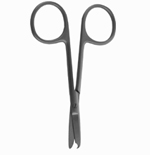FOLLOW UP AND SUTURE REMOVAL
The patient is seen one week after dental implant placement for suture removal, postsurgical instructions, and observation of healing. Careful attention is given to the possibility of soft tissue, hard tissue, and/or dental implant infection. The patient is seen again six weeks post-placement with the expectation that soft-tissue healing should be complete. At this time, oral hygiene is reviewed and a maintenance appointment is scheduled.
The patient is scheduled three months post-placement for a maintenance appointment and observation appointment. A radiograph is taken of the dental implant at this time to evaluate hard-tissue levels. Bone levels should be stable with no evidence of peri-implant platform or periapical radiolucency. At this time, the dentist can determine when the patient can be scheduled for phase II uncovering and/or restoration.
POSTSURGICAL INSTRUCTIONS
FOR THE REMAINDER OF THE DAY:
1) Do not spit. Use a tissue to wipe your mouth as needed, or swallow your saliva.
2) Do not use a drinking straw. Drink straight from the cup.
3) Do not smoke.
4) Keep fingers and tongue away from the surgical area.
Spitting, the use of a straw, smoking, and poking can dislodge the blood clot that is forming, and will cause bleeding from the area. Also,
smoking can increase the chances of an infection.
FOR BLEEDING:
Some minor bleeding is expected after implant surgery. It will usually subside quickly, and stop within an hour or two after surgery. A little
oozing is normal and may persist for several hours, Upper implants may occasionally trigger some bleeding from the nose, This is normal
and will stop quickly.
1) Keep gauze on the surgical area with some pressure for 30 to 45 minutes.
2) Remove the gauze after 30 to 45 minutes, and replace it with a new piece of gauze if you are still bleeding. It is important to make sure
the gauze is directly on the surgical site. Firm pressure for another hour should stop the bleeding.
3) If you find that this is not working after your third attempt, use a moistened tea bag instead of the gauze. The tannic acid in tea will help
to form a clot, and stop the bleeding.
4) If all else fails, call the of?ce.
FOR SWELLING:
Most patients will experience some swelling after surgery in the mouth. It may be mild or severe, and is different for every patient. The
swelling will get bigger for the ?rst 24 to 48 hours before it starts to go away. It may last for several days to one week. Some bruising may
also develop on the face.
1) Use an ice pack on the cheek or face next to the surgical site. Keep it on for 15 to 20 minutes, then off for 10 minutes, and repeat until
you go to sleep. Start again the next day.
2) Sleep with you head elevated slightly, above the heart. This will keep swelling down.
3) On the third day, change to moist heat instead of ice packs. This will bring the swelling down quicker.
EATING:
You may eat soft foods as soon as the anesthetic wears off. Try not to chew directly on the surgical site. You may resume a regular diet
as soon as you feel up to it. Please stay well nourished, and well hydrated, you will heal faster.
BRUSHING:.
You may brush your teeth, avoiding the surgical area, either tonight, or tomorrow morning. Be gentle, and do not spit or rinse forcefully.
Start brushing the surgical area on the second day, and be very gentle on the stitches.
RINSING:
You may start rinsing today, gently, with some warm salty water every few hours. Do not use alcohol-containing mouthrinses for a few
days.
MEDICATIONS:
You were probably given one or more prescriptions for medications. Take all medications with a full glass of water, and as directed on the
bottle. Call us if you experience severe nausea, or diarrhea, or cannot swallow your pills.
1) Antibiotics: Continue until the bottle is empty. Do not quit halfway.
2) Pain Medicine: Continue as necessary. Remember that narcotics can make you drowsy, so no driving, operating machinery, or alcoholic
beverages while you are taking them.
3) Mouth rinse: Peridex or Periogard. Swish with one-half ounce for thirty seconds, and spit it out, two times per day

